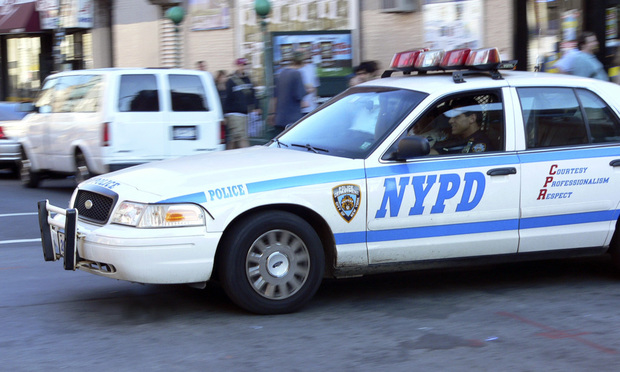NYPD Must Answer Public Records Request Over Cellphone Monitoring, Judge Rules
“Terrorism-related concerns cannot be used to justify the use of a Glomar response in every FOIL context,” Manhattan Supreme Court Justice Arlene Bluth wrote in her decision. She said that “the petitioners here are protestors, engaging in First-Amendment protected activity."
January 15, 2019 at 06:05 PM
6 minute read
 NYPD. Photo: Bigstock
NYPD. Photo: Bigstock
In a strongly worded opinion addressing New York's Freedom of Information Law, a Manhattan Supreme Court justice has ruled that the New York City Police Department must release information to a police protest group about whether the department used technology to monitor or interrupt their cellphones during protests.
The decision from Justice Arlene Bluth could have wider implications for the NYPD's use of devices such as Stingrays, which mimic cell towers and intercept communications, and it comes after the NYPD had given a so-called “Glomar response”—essentially a nonresponse—to the group's FOIL request for information about surveillance of their social media activity and cellphones.
Glomar responses to freedom of information requests are rare and are typically used by federal agencies seeking to minimize national security risks. The responses state only that a government department or agency “can neither confirm nor deny” the existence of an investigation or records.
In the lawsuit before Bluth, a local group called Millions March NYC, which is affiliated with the Movement for Black Lives, argued that the NYPD's Glomar response failed to sufficiently address its 2017 FOIL request seeking documents tied to the NYPD's suspected monitoring of or interference with protesters' cellphones. According to the New York Civil Liberties Union, which teamed with Millions March to both lodge the FOIL request and bring the subsequent lawsuit, some protest organizers saw their phones shut down during marches or received messages indicating possible messaging-interference.
On Monday, Bluth ruled that the NYPD will have to provide documents or a non-Glomar FOIL exemption in response to certain FOIL requests submitted by the group. The police department had used Glomar to avoid giving substantive information in response to the majority of the requests filed in the group's multipronged submission.
“[The NYPD] may decline to provide records, but it must confirm or deny whether such records exist,” Bluth wrote as part of her ruling.
The justice also made clear—in detailed and often forcefully worded reasoning—that the case before her, involving the Millions March group's political protests and marches, was not the right situation for a Glomar response to be invoked.
“Terrorism-related concerns cannot be used to justify the use of a Glomar response in every FOIL context,” Bluth wrote, adding that “the petitioners [Millions March] here are protestors, engaging in First-Amendment protected activity. The only connection between protestors and terrorists appears to be that both groups use cell phones.”
In closing the opinion, she also said, “To embrace the use of Glomar response here would shut off all public inquiry and require respondent [NYPD] to hold itself accountable. That notion runs counter to the very purpose of freedom of information statutes. It certainly would not give terrorists the 'combination to the safe' to admit or deny that responsive records exist and, if such records exist, to offer a legitimate reason for citing an exemption. … FOIL is not about blind trust—it is about holding government officials accountable. That principle is fundamental to a democratic society and cannot be cast aside so easily.”
The NYPD issued a statement saying that it would review Bluth's decision and discuss its options with the city Law Department.
In addition, the department stated that “the NYPD uses the Glomar response exceedingly sparingly and only after careful consideration of the interests involved, including transparency, the need to protect the integrity of criminal investigations and public safety.”
In its own statement, the NYCLU hailed Bluth's ruling, and it criticized what it said was the NYPD's attempt to greatly “expand” the scope and use of Glomar in replying to a legitimate FOIL request.
“The court confirmed that the NYPD cannot vastly expand the scope of the Glomar response to deny the public access to basic information regarding the tactics and technologies used by police to monitor First Amendment-protected political activity,” Bobby Hodgson, an NYCLU staff attorney who argued the case, said.
“The court agreed that allowing the police to cite very general national security concerns in this case—to avoid transparency and accountability over the surveillance of protesters—would undermine the very purpose of the Freedom of Information Law,” he added.
In her opinion, Bluth also knocked back the NYPD's attempt to use an affidavit from John Miller, an NYPD deputy commissioner for intelligence and counterterrorism, who had warned in it, according to Bluth—quoting the affidavit—that revealing whether the NYPD had records responsive to the FOIL request would “potentially provide persons intent on committing a crime or an act of terrorism with critical intelligence to both successfully carry out such crime or attack and successfully evade detection because they would have the specific knowledge of the tools the NYPD may access in preventing attacks.”
Countered Bluth, “Although this affidavit provides ample reasons why a FOIL request for counter-terrorism information might merit a Glomar response, it does not provide any explanation for how it applies to this case. … Miller does not claim that these protestors were affiliated with the terrorists he lists in his affidavit, that these protestors engaged in behavior that might be connected to terrorism or that there might be terrorists hidden among the protestors. In fact, Miller does not allege that these protestors engaged in any terrorism-related behavior whatsoever.”
In addition, wrote the judge, “Miller appears to insinuate that deliberately using technology to interfere with protestors' cellphones would violate the law. If that were the case then, of course, respondent [NYPD] should be able to deny that any records exist because respondent, according to respondent, cannot interfere with a lawful protest. Revealing that the NYPD follows the law would not provide aid or comfort to terrorists. Of course, if respondent is using technology on protestors and, by its own account, violating the law, then it cannot hide exposure of that fact through a Glomar response.”
Bluth's decision in the 2017-filed lawsuit Millions March NYC v. NYPD pertained specifically to two prongs of the the group's FOIL request. In regard to a prong-request asking, in part, for records identifying and describing any software or technology that the NYPD uses to monitor protestors' social media, the justice ordered the police department to release unredacted documents relating to any such software or technology.
This content has been archived. It is available through our partners, LexisNexis® and Bloomberg Law.
To view this content, please continue to their sites.
Not a Lexis Subscriber?
Subscribe Now
Not a Bloomberg Law Subscriber?
Subscribe Now
NOT FOR REPRINT
© 2025 ALM Global, LLC, All Rights Reserved. Request academic re-use from www.copyright.com. All other uses, submit a request to [email protected]. For more information visit Asset & Logo Licensing.
You Might Like
View All
Class Certification, Cash-Sweep Cases Among Securities Litigation Trends to Watch in 2025
6 minute read
Health Care Data Breach Class Actions Saw December Surge in NY Courts

AI Startup Founder Defrauded Investors of Millions, US Prosecutors Say
3 minute read
Legal Leaders See AI's Multitude of Uses as Both Blessing and Curse
Trending Stories
- 1X Faces Intense Scrutiny as EU Investigation Races to Conclusion & Looming Court Battle
- 2'Nation is in Trouble': NY Lawmakers Advance Bill to Set Parameters for Shielding Juror IDs in Criminal Matters
- 3Margolis Edelstein Broadens Leadership With New Co-Managing Partner
- 4Menendez Asks US Judge for Bond Pending Appeal of Criminal Conviction
- 5Onit Acquires Case and Matter Management Software Provider Legal Files Software
Who Got The Work
J. Brugh Lower of Gibbons has entered an appearance for industrial equipment supplier Devco Corporation in a pending trademark infringement lawsuit. The suit, accusing the defendant of selling knock-off Graco products, was filed Dec. 18 in New Jersey District Court by Rivkin Radler on behalf of Graco Inc. and Graco Minnesota. The case, assigned to U.S. District Judge Zahid N. Quraishi, is 3:24-cv-11294, Graco Inc. et al v. Devco Corporation.
Who Got The Work
Rebecca Maller-Stein and Kent A. Yalowitz of Arnold & Porter Kaye Scholer have entered their appearances for Hanaco Venture Capital and its executives, Lior Prosor and David Frankel, in a pending securities lawsuit. The action, filed on Dec. 24 in New York Southern District Court by Zell, Aron & Co. on behalf of Goldeneye Advisors, accuses the defendants of negligently and fraudulently managing the plaintiff's $1 million investment. The case, assigned to U.S. District Judge Vernon S. Broderick, is 1:24-cv-09918, Goldeneye Advisors, LLC v. Hanaco Venture Capital, Ltd. et al.
Who Got The Work
Attorneys from A&O Shearman has stepped in as defense counsel for Toronto-Dominion Bank and other defendants in a pending securities class action. The suit, filed Dec. 11 in New York Southern District Court by Bleichmar Fonti & Auld, accuses the defendants of concealing the bank's 'pervasive' deficiencies in regards to its compliance with the Bank Secrecy Act and the quality of its anti-money laundering controls. The case, assigned to U.S. District Judge Arun Subramanian, is 1:24-cv-09445, Gonzalez v. The Toronto-Dominion Bank et al.
Who Got The Work
Crown Castle International, a Pennsylvania company providing shared communications infrastructure, has turned to Luke D. Wolf of Gordon Rees Scully Mansukhani to fend off a pending breach-of-contract lawsuit. The court action, filed Nov. 25 in Michigan Eastern District Court by Hooper Hathaway PC on behalf of The Town Residences LLC, accuses Crown Castle of failing to transfer approximately $30,000 in utility payments from T-Mobile in breach of a roof-top lease and assignment agreement. The case, assigned to U.S. District Judge Susan K. Declercq, is 2:24-cv-13131, The Town Residences LLC v. T-Mobile US, Inc. et al.
Who Got The Work
Wilfred P. Coronato and Daniel M. Schwartz of McCarter & English have stepped in as defense counsel to Electrolux Home Products Inc. in a pending product liability lawsuit. The court action, filed Nov. 26 in New York Eastern District Court by Poulos Lopiccolo PC and Nagel Rice LLP on behalf of David Stern, alleges that the defendant's refrigerators’ drawers and shelving repeatedly break and fall apart within months after purchase. The case, assigned to U.S. District Judge Joan M. Azrack, is 2:24-cv-08204, Stern v. Electrolux Home Products, Inc.
Featured Firms
Law Offices of Gary Martin Hays & Associates, P.C.
(470) 294-1674
Law Offices of Mark E. Salomone
(857) 444-6468
Smith & Hassler
(713) 739-1250






